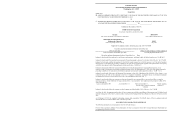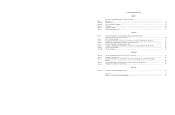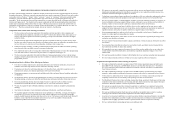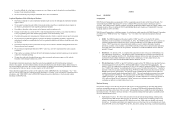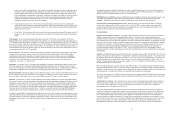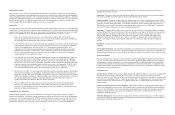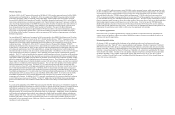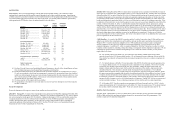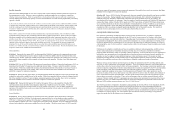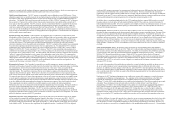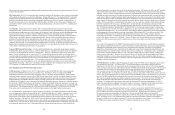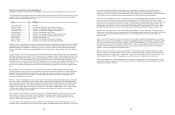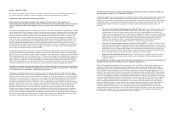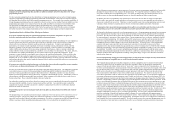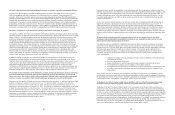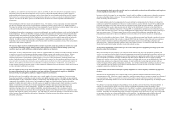Dish Network 2012 Annual Report Download - page 11
Download and view the complete annual report
Please find page 11 of the 2012 Dish Network annual report below. You can navigate through the pages in the report by either clicking on the pages listed below, or by using the keyword search tool below to find specific information within the annual report.
10
10
Satellite Anomalies
Operation of our DISH branded pay-TV service requires that we have adequate satellite transmission capacity for
the programming we offer. Moreover, current competitive conditions require that we continue to expand our
offering of new programming. While we generally have had in-orbit satellite capacity sufficient to transmit our
existing channels and some backup capacity to recover the transmission of certain critical programming, our backup
capacity is limited.
In the event of a failure or loss of any of our satellites, we may need to acquire or lease additional satellite capacity
or relocate one of our other satellites and use it as a replacement for the failed or lost satellite. Such a failure could
result in a prolonged loss of critical programming or a significant delay in our plans to expand programming as
necessary to remain competitive and thus may have a material adverse effect on our business, financial condition
and results of operations.
Prior to 2012, certain of our owned and leased satellites have experienced anomalies, some of which have had a
significant adverse impact on their remaining useful life and/or commercial operation. There can be no assurance
that future anomalies will not further impact the remaining useful life and/or commercial operation of any of the
satellites in our fleet. See “Long-Lived Assets” in Note 2 in the Notes to our Consolidated Financial Statements in
Item 15 of this Annual Report on Form 10-K. There can be no assurance that we can recover critical transmission
capacity in the event one or more of our in-orbit satellites were to fail. We generally do not carry commercial
insurance for any of the in-orbit satellites that we use, other than certain satellites leased from third parties, and
therefore, we will bear the risk associated with any uninsured in-orbit satellite failures. Recent developments with
respect to certain of our satellites are discussed below.
Owned Satellites
EchoStar I. During the first quarter 2012, we determined that EchoStar I experienced a communications receiver
anomaly. The communications receivers process signals sent from our uplink center for transmission back to our
customers by the satellite. While this anomaly did not impact commercial operation of the satellite, there can be no
assurance that future anomalies will not impact its future commercial operation. EchoStar I was fully depreciated
during 2007.
EchoStar VII. Prior to 2012, EchoStar VII experienced certain thruster failures. During the fourth quarter 2012, we
determined that EchoStar VII experienced an additional thruster failure. Thrusters control the satellite’s location
and orientation. While this anomaly did not reduce the estimated useful life of the satellite to less than 15 years or
impact commercial operation of the satellite, there can be no assurance that future anomalies will not reduce its
useful life or impact its commercial operation.
EchoStar XI. During the first quarter 2012, we determined that EchoStar XI experienced solar array anomalies that
reduced the total power available for use by the satellite. While these anomalies did not reduce the estimated useful
life of the satellite to less than 15 years or impact commercial operation of the satellite, there can be no assurance
that future anomalies will not reduce its useful life or impact its commercial operation.
EchoStar XIV. During the third quarter 2011 and the first quarter 2012, we determined that EchoStar XIV
experienced solar array anomalies that reduced the total power available for use by the satellite. While these
anomalies did not reduce the estimated useful life of the satellite to less than 15 years or impact commercial
operation of the satellite, there can be no assurance that future anomalies will not reduce its useful life or impact its
commercial operation.
Leased Satellites
EchoStar VI. Prior to 2012, EchoStar VI experienced solar array anomalies which impacted the commercial
operation of the satellite. EchoStar VI also previously experienced the loss of traveling wave tube amplifiers
(“TWTAs”). During the first quarter 2012, EchoStar VI experienced the loss of two additional TWTAs increasing
the total number of TWTAs lost to five. During the second quarter 2012, EchoStar VI lost an additional solar array
string, which reduced the total power available for use by the satellite. While the recent losses of TWTAs and the
11
11
solar array strings did not impact current commercial operation of the satellite, there can be no assurance that future
anomalies will not impact its commercial operation.
EchoStar XII. Prior to 2012, EchoStar XII experienced solar array anomalies that reduced the total power available
for use by the satellite. During September and November 2012 and January 2013, EchoStar XII experienced
additional solar array anomalies, which further reduced the total power available for use by the satellite. An
investigation of the anomalies is continuing. Since the number of useable transponders on EchoStar XII depends on,
among other things, whether EchoStar XII is operated in CONUS, spot beam, or hybrid CONUS/spot beam mode,
we are unable to determine at this time the actual number of transponders that will be available at any given time or
how many transponders can be used during the remaining estimated life of the satellite. Additional solar array
anomalies are likely to continue to degrade operational capability in all of the possible modes. This satellite is
currently in-service and projected to be an in-orbit spare effective March 1, 2013.
GOVERNMENT REGULATIONS
Our operations, particularly our DBS operations and our wireless spectrum licenses, are subject to significant
government regulation and oversight, primarily by the FCC and, to a certain extent, by Congress, other federal
agencies and foreign, state and local authorities. Depending upon the circumstances, noncompliance with legislation
or regulations promulgated by these entities could result in limitations on, or in the suspension or revocation of our
licenses or registrations, the termination or loss of contracts or the imposition of contractual damages, civil fines or
criminal penalties, any of which could have a material adverse effect on our business, financial condition and results
of operations.
Furthermore, the adoption or modification of laws or regulations relating to video programming, satellite services,
wireless telecommunications, broadband, the Internet or other areas of our business could limit or otherwise
adversely affect the manner in which we currently conduct our business. If we become subject to new regulations or
legislation or new interpretations of existing regulations or legislation that govern Internet network neutrality, for
example, we may be required to incur additional expenses or alter our business model. The manner in which
legislation governing Internet network neutrality may be interpreted and enforced cannot be precisely determined,
which in turn could have an adverse effect on our business, financial condition and results of operations.
Wireless services and our wireless spectrum licenses are subject to regulation by the FCC and other federal, state
and local, as well as international, governmental authorities. These governmental authorities could adopt regulations
or take other actions that would adversely affect our business prospects. The licensing, construction, operation, sale
and interconnection arrangements of wireless telecommunications systems are regulated by the FCC and, depending
on the jurisdiction, other federal and international, state and local regulatory agencies. In particular, the FCC
imposes significant regulation on licensees of wireless spectrum with respect to how radio spectrum is used by
licensees, the nature of the services that licensees may offer and how the services may be offered, and resolution of
issues of interference between spectrum bands. The FCC grants wireless licenses for terms of generally ten years
that are subject to renewal or revocation. There can be no assurances that our wireless spectrum licenses will be
renewed. Failure to comply with FCC requirements in a given license area could result in revocation of the license
for that license area. For further information related to our licenses and build-out requirements related to our 700
MHz and 2 GHz wireless spectrum licenses see “Item 1A. Risk Factors.”
The following summary of regulatory developments and legislation in the United States is not intended to describe
all present and proposed government regulation and legislation affecting the video programming distribution,
satellite services, wireless telecommunications and broadband industries. Government regulations that are currently
the subject of judicial or administrative proceedings, legislative hearings or administrative proposals could change
our industries to varying degrees. We cannot predict either the outcome of these proceedings or any potential
impact they might have on the industry or on our operations.



